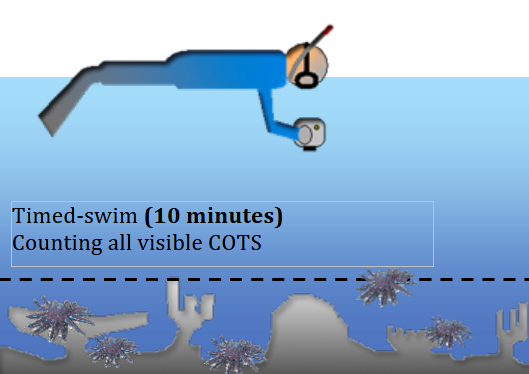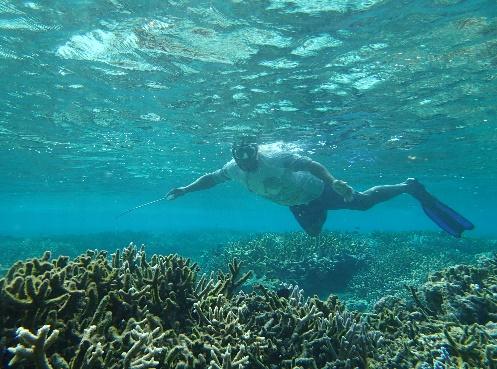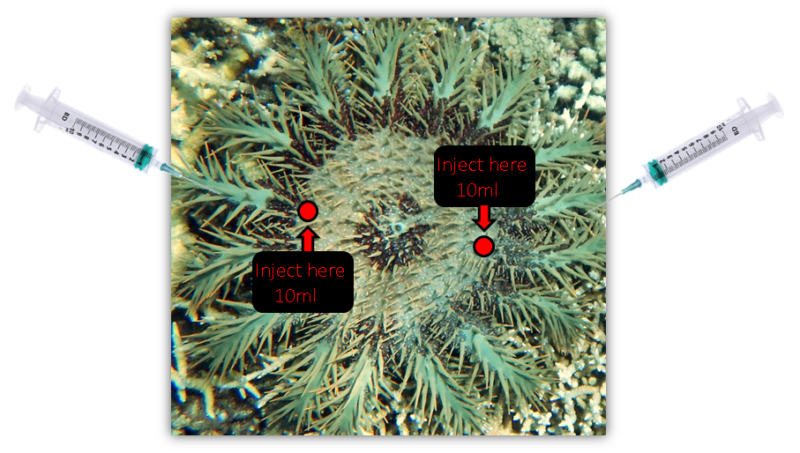Monitoring COTS: simple survey protocol
For the data to be reliable, it is important that observers in a given area use the same survey protocol to monitor COTS. We recommend the « timed-swim » method (English et al. 1997), used to monitor COTS population in New Caledonia and in Vanuatu. Not only this method doesn’t require scientific knowledge but it also provides robust data, allowing to compare COTS populations across different locations and different periods.
The method relies on series of individual counting lasting 10 minutes, carried out from the surface (but also possible while diving) during which the operators slowly swims and actively searches for COTS. Each specimen observed is counted, and the total number of COTS observed is written down at the end of the 10 minutes. The process should be conducted by a team of 2-5 snorkelers (depending on the reef area) deployed across the entire width of the reef, and repeated until the whole target area is covered.


© Pascal Dumas – IRD.
COTS surveys are best carried out by local reef stakeholders who regularly go underwater on the reef in their normal activities: local fishermen, divers, and potentially tourists engaging in underwater activities. After having completed one or several surveys, the operator reports the exact location and number of COTS observed for each survey either to a designated local contact (for instance in the nearby village) or to the organization running the monitoring program. He can also registers the results on a dedicated website or a smartphone app if such a tool has been made available.
In a given location, carrying out survey of COTS once a month is recommended. When the reef areas to be monitored for COTS outbreaks are very large, and such a frequency not realistic, areas need to be prioritized according to their importance (reefs still in good condition, reefs essential for local subsistence and economy, diving spots etc.).
Once an outbreak has occurred in one location, it is worth to specifically monitor nearby reefs more frequently in the followings months, as a group of COTS that has finished to eat most of the corals on one location may move to nearby reefs.
Making a decision
Determining the COTS outbreak level and the associated risks for the ecosystems depends on the local reef context, notably the reef structure and extension, and the abundance and diversity of coral cover. However it is possible to classify the COTS outbreak risk in 3 categories, using threshold reference values developed in New Caledonia by Dumas et al. (2020). An outbreak is confirmed when the average number of COTS observed during the 10-min timed-swims is greater than or equal to 5 individuals (during daytime). This average number has to be balanced with reef size and the number of individual counts, as outbreaks are patchy by nature (i.e. can affect only specific portions of a reef).
| LEVEL | NBR OF COTS in 10 MIN | EQUIVALENT in COTS.ha-1 | OUTBREAK LEVEL | COTS OUTBREAK RISK |
|---|---|---|---|---|
| 1 | 0-1 | <15 | No outbreak | Low |
| 2 | 2-4 | 15-100 | Possible outbreak | Moderate (to monitor) |
| 3 | ≥ 5 | >100 | Confirmed outbreak | High (intervention recommended) |
NB: at night, more COTS are usually observed, so the values used to determine the risk of an outbreak are different (higher threshold).
Culling a COTS outbreak
Product for injecting COTS
If available, the easiest solution is supermarket-bought white vinegar, with 4-5% acetic acid.
If a large supply of vinegar is unavailable, lime or passion fruit juice can also be used. For operating in very remote areas where the weight of the product is a concern, it is possible to use powdered acids to be mixed with water, though there are generally more expensive than vinegar. Among these, powdered citric acid shows an efficiency similar to that of vinegar or lime juice, and can be easily diluted in the field with seawater. Powdered oxalic acid, which shows similar efficiency, needs to be diluted with fresh water.
Equipment
Injection kits are composed of an injection gun, onto which is mounted a 16G (Birmingham gauge) needle, linked to ideally a 5L reservoir. Ideally, injector needs to be able to deliver a 10ml dose per injection. Some husbandry products can be used.
Due to regular contact with seawater, in order to prevent rust and corrosion, the equipment must be carefully rinsed with freshwater daily once operations are over, and dried if not used for several days.
Cleaning the outbreak
Each starfish requires 2 injections of 10ml in two different areas of the body. The most effective location to inject the product is at the base of one of the starfish’s arms (i.e. opposite to arm tip).
To cover the whole reef, divers advance in a line covering the breadth of the reef and inject all COTS in their range, taking care to locate the ones hidden underneath table corals or nested in coral assemblages. Shallower areas can be done by freedivers while deeper areas are more easily cleaned by scuba divers.
A second pass should be done after 24 hours. All injected COTS should then show strong signs of disintegrating, allowing to inject the ones still intact. Additional passes can be done later, to make sure none have escaped.

Table of contents
- Introduction video on COTS
- Information on COTS and COTS outbreaks
- COTS field operations (this page)
- COTS equipment: DIY and suppliers
Credits
This material was put together for a workshop held in 2021 in Kendari, Southeast Sulawesi, Indonesia, with local diving clubs and government agencies involved in natural resources management. It was put together by Pascal Dumas (IRD – Centre de Nouméa, New Caledonia) and Yann Bigant (Naturevolution) and translated into Indonesian by Mutmainnah (Naturevolution Indonesia).




